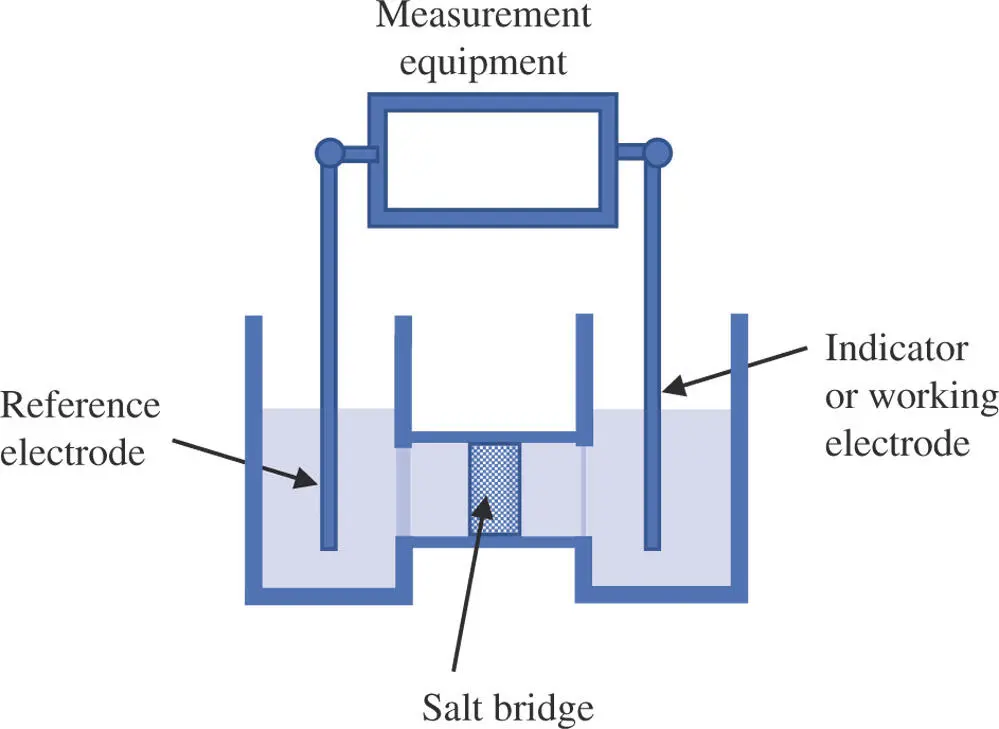1.2.6 Methods Based on Voltage Measurement Versus Current Measurement
Potentiometry is a category of electroanalytical techniques that involves measuring the potential energy difference that develops at the boundary between a sensor and the sample solution as a function of the analyte concentration in the sample solution in which current does not flow. Alternatively, one can use an external power source, such as a battery, to impose a voltage to an electrode surface. This strategy drives an electron transfer reaction between an electrode and analyte in solution at select voltages. Current is measured in these experiments, and it may be proportional to analyte concentration under the right conditions. Voltammetry is a category of methods that measure the current in response to applying a range of voltages to the electrode/solution interface. The term “voltammetry” implies that the voltage is scanned in some manner. If the voltage is held at a constant value while measuring the current, the technique is called amperometry.
1.3 Electrochemical Cells
1.3.1 Electrodes
Electroanalytical experiments are built around electrochemical cells (see Figure 1.4). There are some common features to electrochemical cells used for both potentiometry and voltammetry. The signal‐generating event occurs at an electrode surface or, more precisely, at the boundary between the sample solution and an electrode surface. In voltammetry experiments, this electrode is often called the working electrode and is made from a metal that is not easily corroded, such as gold or platinum, or a highly conducting form of carbon. In potentiometry experiments, the signal is a voltage that develops at the indicator electrode. The indicator electrode may be as simple as a metal conductor in some experiments, but it is often a more elaborate device. Ideally, no current passes during a potentiometric measurement. The potential being measured is sometimes called the open circuit potential or the rest potential to emphasize the fact that passing a significant amount of current during the measurement can distort the signal. Potentiometric devices are discussed in depth in Chapters 2and 3.

Figure 1.4Basic arrangement of an electrochemical cell. Two electrodes are required to complete a circuit for the movement of charge. Each electrode is isolated in its own solution (or “half‐cell”). A salt bridge keeps the two solutions from mixing but allows some ions to cross in order to complete the electrical circuit. The measurement equipment may be as simple as a voltmeter in a potentiometry experiment or, in the case of a voltammetry experiment, it may include a power source and a current meter.
One electrode is not enough. Measuring current or voltage at an electrode requires that the device be incorporated into an electrical circuit (see Figure 1.4). The external equipment may be as simple as a voltmeter in a potentiometry experiment or a combination of a current meter and a voltage control unit (called a potentiostat) in the case of a voltammetry experiment. The circuit provides a path for charge to move from the external measuring device into the electrochemical cell and back out again to the meter in a complete loop. For example, consider a voltammetry experiment. If the external equipment pushes electrons into the working electrode to drive a reduction reaction (where some chemical species in solution accepts electrons from the electrode), then there must be a mechanism that can return electrons from the cell to the outside circuit to complete the cycle. A second electrode is introduced to provide a path for electrons to return to the meter. This second electrode is known as a reference electrode.
Occasionally, the components of an electrochemical cell are summarized in a schematic diagram written on a single line, such as this:

A single slanted line, /, indicates a phase boundary and a double slanted line, //, indicates a salt bridge separating the two half‐cells. A potential may develop at any of those boundaries. The salt bridge may be as simple as a porous glass frit filled with a salt solution. It has two boundaries, one facing each of the two half‐cell solution compartments. Components separated by a comma are together in the same solution. Electrode materials are specified at the beginning and the end of the line. The electrode where an oxidation process occurs appears on the left and is known as the anode. The electrode for the half‐cell where a reduction process occurs appears on the far right. In this case, a copper electrode is placed in a solution of copper(II) ions together with an electrolyte solution of 0.1 M potassium nitrate. A salt bridge separates the first solution from a potassium chloride solution. In contact with the KCl solution, is a silver wire that has a coating of silver chloride. This particular diagram indicates that the two half‐cell reactions are


This type of diagram is more common in energy storage (batteries) and power generation systems, such as fuel cells. In many electroanalytical experiments, an external power source is used to apply a voltage to the system to drive a reaction of interest. In those cases, the applied voltage frequently changes in a manner so that the roles of the electrodes are reversed one or more times during the experiment. Therefore, such a diagram is only partly informative. A detailed description of the experimental conditions is more appropriate.
In a voltammetry experiment, it is necessary to apply a voltage to the working electrode in order to drive the reaction there. For that reason, it is very important to know how much energy is being applied to the working electrode. Reference electrodes are constructed so that the voltage at their surfaces remains constant. Consequently, any voltage applied to the cell from the outside is completely focused on the interface between the working electrode and the sample solution. A stable reference electrode is also essential for potentiometric experiments where the chemical composition of the solution induces a potential at the indicator electrode. The steadfastness of the reference electrode potential assures the experimenter that voltage changes in the cell represent potential changes of the same magnitude at the indicator electrode. Electrochemists say that the reference electrode is nonpolarizable; it is able to transfer whatever current is needed without budging from its reference potential. How reference electrodes maintain their nonpolarizability is discussed in Chapter 2.
The solution conditions in the immediate environment of the reference electrode are very carefully controlled in order to ensure that the reference electrode potential remains fixed. These conditions are often incompatible with sample solutions. Therefore, the reference solution is frequently isolated from the sample using a salt bridge. This salt bridge is usually a porous ceramic or polymer plug that provides ultrafine pores for the movement of ions but prevents significant mixing between the bulk solutions on opposite sides of the bridge (see Figure 1.4).
Читать дальше
















